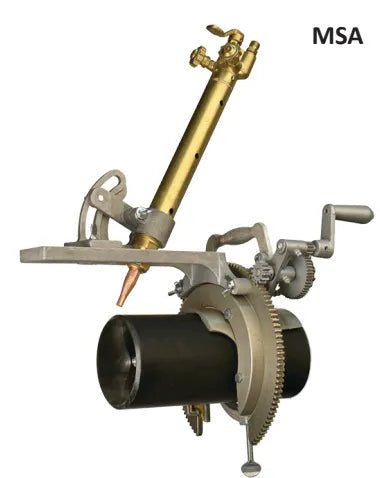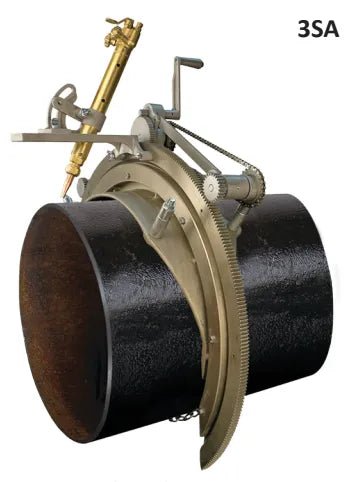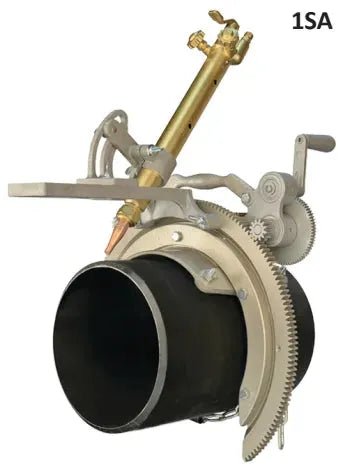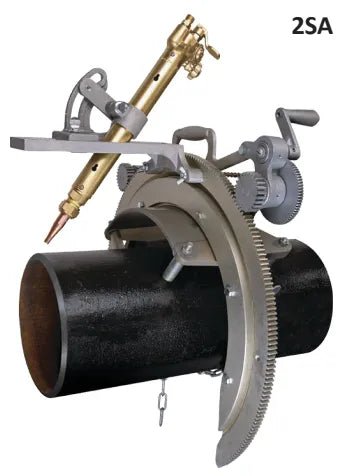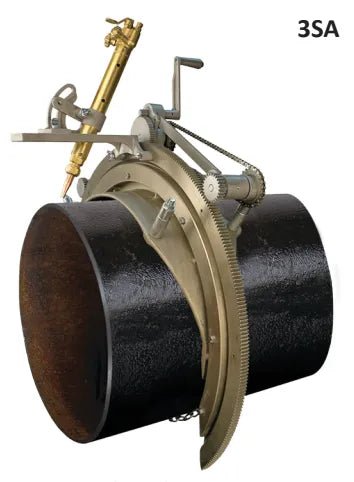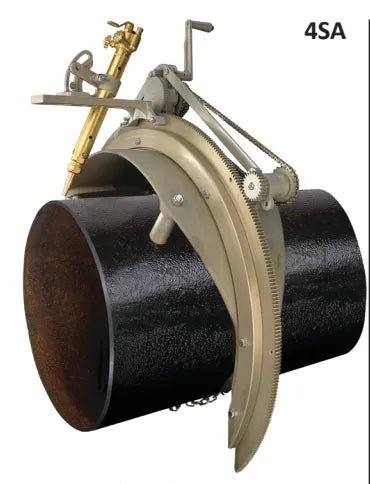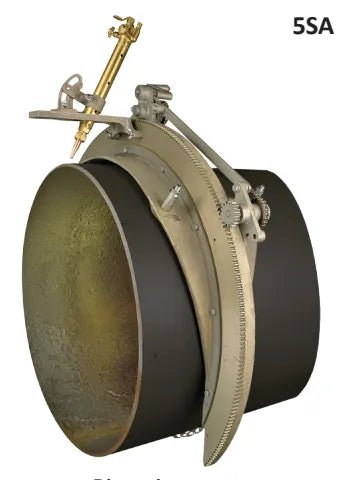What are Saddle Machines?
Saddle machines are precision pipe cutting and beveling tools designed for making clean, accurate cuts on large-diameter pipes. These machines clamp securely onto the pipe, aligning themselves to ensure a square and even cut, which is crucial for high-quality pipe welding applications. Used in industries like oil & gas, pipeline construction, and industrial fabrication, saddle machines allow welders to create precise bevels that improve weld fit-up and penetration. They can be manual or motorized, with some models featuring automatic torch movement for enhanced efficiency.
The design of a saddle machine includes a saddle-shaped frame that sits on the pipe, allowing the cutting tool to travel smoothly along the circumference. Operators can adjust settings to achieve different bevel angles, including V-grooves, J-grooves, and compound bevels, depending on welding requirements. Compared to manual cutting methods, saddle machines reduce errors, improve efficiency, and minimize material waste, making them essential for shops and field welding operations that require consistent, high-quality pipe preparation.
Band Crawlers
Saddle machines are specialized pipe cutting and beveling tools designed for precision, efficiency, and consistency in welding applications. These machines are called “saddle” machines because of their frame-like structure, which allows them to clamp securely onto a pipe, ensuring a steady and accurate cut. They are widely used in industries like oil & gas, pipeline construction, power plants, and fabrication shops, where high-precision pipe preparation is crucial for strong, high-quality weld joints. Unlike manual cutting methods, saddle machines provide clean, repeatable cuts, reducing the need for additional grinding or adjustments before welding.
These machines come in manual and motorized models, with torch or plasma cutting attachments that allow for various bevel angles, including V-bevels, J-bevels, and compound bevels. The motorized versions automate the cutting process, increasing efficiency and reducing operator fatigue, making them ideal for high-volume production and field applications. Saddle machines are versatile, durable, and easy to set up, making them essential for welding professionals who need precise pipe fit-ups that enhance weld strength, reduce defects, and improve overall productivity.
FAQ's About Pipe Cutting & Beveling
What is pipe cutting and beveling, and why is it important in welding?
What are the different methods used for pipe cutting and beveling?
The most common methods include:
- Oxy-Fuel Cutting – Ideal for carbon steel pipes, using a torch to burn through the material.
- Plasma Cutting – Provides high-precision cuts on stainless steel and non-ferrous metals.
- Mechanical Cutting – Includes band saws, rotary cutters, and pipe lathe machines, offering cold cutting with no heat-affected zone (HAZ).
- Saddle Machines & Band Crawlers – Portable, field-ready tools for consistent and precise pipe cutting and beveling.
What are the most common bevel types used in welding?
The main bevel types include:
- V-Bevel – A straight, angled cut commonly used in butt weld joints.
- J-Bevel – A more rounded edge, reducing the amount of filler metal needed.
- Compound Bevel – A combination of angles, enhancing weld strength and penetration.
How do I choose between a saddle machine and a band crawler for pipe cutting?
Yes, but different materials require different methods:
- Carbon steel – Oxy-fuel, plasma, or mechanical cutting.
- Stainless steel & alloys – Plasma or cold cutting methods to prevent material contamination.
- Plastic & non-metallic pipes – Mechanical cutting methods like rotary saws or band saws.
Featured Products
Pipe Cutting & Bevelin
Saddle Machines: Setup, Usage, and Benefits
Saddle machines are essential tools for precise pipe cutting and beveling, commonly used in pipeline welding, fabrication shops, and industrial construction. These machines are designed to create consistent, smooth bevels for strong, high-quality weld joints.
Setup of a Saddle Machine:
- Pipe Preparation – Before mounting the saddle machine, ensure the pipe is clean and free of debris, rust, or coatings that could affect the machine’s alignment.
- Positioning the Machine – The saddle machine is clamped securely onto the pipe, ensuring it sits flush against the surface for an accurate cut.
- Adjusting the Torch or Cutting Tool – Based on the pipe thickness and material, the oxy-fuel or plasma torch is adjusted for proper cutting depth and angle.
- Calibration & Alignment – The machine is aligned with the pipe’s circumference to ensure an even, square cut or beveled edge based on the welding requirements.
Using a Saddle Machine:
- Once set up, the machine is manually operated or motor-driven to move smoothly along the pipe’s surface, guiding the cutting tool along a precise path.
- Adjustable settings allow welders to create various bevel angles, including V-grooves, J-grooves, or compound bevels, depending on the welding process.
- The finished cut provides a clean, consistent edge, reducing the need for additional grinding or edge prep, ultimately improving welding efficiency.
Why Welding Shops Need a Saddle Machine:
- Ensures consistent, high-precision cuts for better weld fit-up and joint strength.
- Reduces material waste by minimizing errors in cutting and beveling.
- Speeds up production times compared to manual cutting methods.
- Ideal for shop fabrication and industrial pipeline applications.
Band Crawlers: Setup, Usage, and Benefits
Band crawlers (also known as pipe cutting band saws) are specialized portable pipe cutting tools designed for on-site and field applications. Unlike saddle machines, which clamp onto the pipe, band crawlers use a flexible band that wraps around the pipe, allowing for smooth, even cuts on large-diameter pipes.
Setup of a Band Crawler:
Pipe Surface Preparation – The pipe should be free of dirt, coatings, or obstructions that might affect the band’s tracking.
Band Installation – The flexible band is placed around the pipe, adjusted to the correct diameter, and locked in place.
Aligning the Cutting Torch or Saw – The oxy-fuel or plasma torch is mounted onto the band crawler’s guide arm, ensuring it follows a precise cutting path.
Securing the Drive Unit – If the band crawler is motorized, the drive unit is positioned and tested for smooth operation.
Using a Band Crawler:
Once the system is locked onto the pipe, the torch moves along the track to ensure a clean, precise cut.
Automated or manually controlled models ensure uniform cutting speed, reducing operator fatigue and minimizing errors.
Band crawlers can cut large-diameter pipes in the field, making them essential for pipeline construction and repair projects.
Why a Welding Shop Might Need a Band Crawler:
Ideal for on-site pipeline welding, where portability and versatility are essential.
Provides clean, accurate cuts on large-diameter pipes that may be difficult to handle in a shop setting.
Reduces the need for grinding and additional edge prep, saving time and labor.
Works on a variety of pipe materials, including carbon steel, stainless steel, and alloys.
Which One Should a Welding Shop Have?
Both saddle machines and band crawlers serve critical roles in pipe fabrication and welding. A welding shop that primarily fabricates pipes in-house benefits from saddle machines for high-precision cutting and beveling. However, for shops involved in field pipeline work or on-site repairs, a band crawler is indispensable for mobile, efficient pipe cutting.
By having both saddle machines and band crawlers, welding shops can increase efficiency, reduce errors, and handle a broader range of pipe cutting and beveling tasks, ensuring optimal weld quality across different applications.









